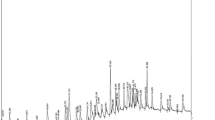Abstract
In samples with 1,009, 7,723, 7,618, 7,618, 1,004 and 1,009 number, oleic acid were found as 62.0, 77.0, 74.84, 71.55, 54.52 and 62.30 %, respectively. In other samples, oleic acid content was determined between 17.43 % (1,589) and 34.86 % (1,298). Linoleic acid content of seed oils ranged from 6.52 % (7,727) to 57.29 % (1,501). In addition, linolenic acid content was found between 0.22 % (7,618) and 46.91 % (1,589). Palmitic acid content of samples changed between 2.03 % (7,727) and 19.81 % (1,298). Capric acid was found at high level in 1,009 (8.53 %), 7,727 (37.31 %) and 1,004 (8.28 %) samples. Caproic acid was found in only 7,727 (3.38 %).
Similar content being viewed by others
References
Akpınar, N., Akpınar, M. A., & Türkoğlu, Ş. (2001). Total lipid content and fatty acid composition of the seeds of some Vicia L. species. Food Chem, 74, 449–453.
Amubode, F. A., & Fetuga, B. L. (1983). Proximate composition and chemical assay of methionine, lysine, tryptophan in some Nigerian Forest trees. Food Chem, 12, 67–72.
Aparico, R., & Aparico Ruiz, R. (2000). Authentication of vegetable oils by chromatographic techniques. Journal of Chromatogr A, 881, 93–104.
Bağcı, E. (2006). Fatty acid composition of some Astragalus species from Turkey. Chemistry of Natural Compounds, 42, 645–648.
Grosso, N. R., Zygadlo, J. A., Lamarque, A. L., Maestri, D. M., & Guzman, C. A. (1997). Proximate, fatty acids and sterol composition of aboriginal peanut (Arahis hypogeae L) seeds from Bolivia. J Sci Food Agric, 3, 349–356.
Hişil, Y. (1998). Instrumental analysis techniques (Eng Fac Publ 55). Bornova, İzmir: Ege Üniversity (in Turkish).
International Standard. (1998). ISO 659: Oilseeds—determination of hexane extract (or light petroleum extract), called “oil content”. Geneva: ISO.
Maestri, D. M., Fortunato, R. H., Guzman, C. A., Torres, M. M., & Lamarque, A. L. (2002). Seed compositional studies of some species of Papilionoideae (Leguminosae) native to Argentina. J Sci Food Agric, 82, 248–251.
Ngo-Duy, C. C., Desraillats, F., & Keskitalo, M. (2009). Triacylglycerols of Apiaceae seed oils: composition and regiodistribution of fatty acids. European Journal of Lipid Science and Technology, 111, 164–169.
Püskülcü, H., & İkiz, F. (1989). Introduction to statistic (Bilgehan Press, p. 333). Turkey: Bornova. İzmir (in Turkish).
Sabudak, T., Ozturk, M., Goren, A. C., Ufuk Kolak, U., & Topcu, G. (2009). Fatty acids and other lipid composition of five Trifolium species with antioxidant activity. Pharm Biol, 47(2), 137–141.
Sokolov, S., & Zamotaev, I. (1984). A guide of pharmaceutical plants. Moscow: Meditsina.
Takeuchi, Y., Yamaoka, Y., Fukushima, S., Miyawaki, K., Taguchi, K., Yasukawa, H., Kishimoto, S., & Suzuki, M. (1998). Skin penetration enhancing action of cis-unsaturated fatty acids with omega-9, omega-12 chain lengths. Biol Pharm Bull, 21, 484–491.
Thangadurai, D. (2005). Chemical composition and nutritional potential of Vigna unguiculata ssp. cylindrica (Fabaceae). J Food Biochem, 29, 88–98.
Thangadurai, D., Viswanathan, M. B., & Ramesh, N. (2001). Nutritional potential of biochemical components in Galactia longifolia Benth. (Fabaceae). Nahrung/Food, 45, 97–100.
Viswanathan, M. B., Thangadurai, D., Vendan, K. T., & Ramesh, N. (1999). Chemical analysis and nutritional assessment of Teramnus labialis (L.) Spreng. (Fabaceae). Plant Foods Hum Nutr, 54, 345–352.
Viswanathan, M. B., Thangadurai, D., & Ramesh, N. (2001). Biochemical and nutritional evaluation of Neonotonia wightii (Wight & Arn.) Lackey (Fabaceae). Food Chem, 75, 275–279.
Weiss, R. (1974). Lehrbuch der Phytoterapie. Stuttgart: Hippokrates.
Zlatanov, M. D., & Antova, G. A. (2004). Composition of biologically active lipids of Lamiaceae seed oils. Grasas y Aceites, 55, 143–147.
Acknowledgments
This work was supported by Selçuk University Scientific Research Project (S.U.-BA.-Project, Konya, Turkey).
Author information
Authors and Affiliations
Corresponding author
Rights and permissions
About this article
Cite this article
Öztürk, M., Geçgel, Ü., Duran, A. et al. The fatty acid compositions of several plant seed oils belong to Leguminosae and Umbelliferae families. Environ Monit Assess 186, 2795–2799 (2014). https://doi.org/10.1007/s10661-013-3580-x
Received:
Accepted:
Published:
Issue Date:
DOI: https://doi.org/10.1007/s10661-013-3580-x




